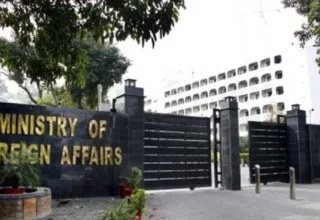
CHINA ECONOMIC NET
ISLAMABAD – The State Bank of Pakistan (SBP) earlier launched the National Payment Strategy System (NPSS) in order to build a road map and action plan for Pakistan to have a modern and robust digital payments network.
The key goal of the strategy is to make the access of the people easier to financial services while helping them to improve financial inclusion in the country, particularly for women, along with greater documentation of the economy.
Therefore, the SBP aimed to develop a faster payment system that would simplify the requesting, receiving and sending of payments in the country. The State Bank of Pakistan, in collaboration with the private sector, would increase the number of digital access points for making easy payments and plans to install additional one million digital access points over the next three years.

SBP also claimed that migration to electronic payments will stimulate consumption and trade, boosting Pakistan’s economy by as much as seven per cent and creating four million jobs by 2025.The Micro Payment Gateway is being implemented in collaboration with the Bill and Melinda Gates Foundation to ensure faster retail payments.
Meanwhile, the World Bank also extended its full support to the central bank in implementation of key economic reforms and action items as highlighted in the strategy.
Cash still dominates Pakistan’s economy, with most wages paid in paper money and merchants largely unable to accept digital payments. Only 21% of adults have a transaction account and of these only seven percent are women.
In developing countries like Pakistan, transparent cashless digital transactions can instill greater confidence in international investors.
Pakistan can acquire much from other developed countries like China to further boost the digital payment system, which is still in its infancy, as the latter has an immense knowledge base, experience and advanced technology in this field.
China’s estimated 890 million unique mobile payment users made transactions totaling around $17 trillion in 2017—more than double the 2016 figure. The number of people making mobile merchant payments raised to 577 million in 2019 and expected to touch almost 700 million in 2022.

Beside many advantages coming with it there are also few challenges and issues with digital payments in country like Pakistan.
For example, cyber security remains a key focus area of the central bank as keeping the system protected from cyber-attacks is a major challenge. Issues related to internet connectivity, power infrastructure, digital payment set-ups and lack of necessary insight among wider society can constrain the outreach of digital transactions.
Cash is not an option but a necessity for a major chunk of our population, as only 21% of Pakistanis have access to formal financial services. Therefore, cashless economy cannot be imposed rather it has to be gradually adopted by general public for successful implementation. The application also needs to be very simple and easy to use so that everyone can understand.
Companies need to gain confidence of such people by offering various incentives. After motivating people to become part of the mobile payment system, they needed to engage them by offering the option to pay on retail stores also because currently digital payment options are available at high-end restaurants, stores and boutiques only, which is not enough.
Digital payment companies can team up with the government and develop an ecosystem for digital payment such that even bakeries, barber shops, betel leaf and even tuck shops would be able to use it.
Common people are familiar with the digital payment system for remittances inside the country like Easypaisa, however, they do not use it for retail payments.
The merchants on the other hand must be taken along and need to be educated to the safety and efficiency of the system and how it would benefit them. Many digital payment solutions have entered Pakistan and awareness of digital payments is the need of the time.
While the added use of smartphones in the country is paving way for the development of e-commerce and new mediums of payment, cash still remains the most preferred payment method in Pakistan. Even with all the developments, a number of roadblocks still lie in the way of an effective digital payment system in the country.
Possibly, there has been a rise in the number of customers opting for digital payments, rather than conventional means, paving the way for a new trend in the industry, although it is yet to be seen on a large scale. The number is still significantly small, though implementing it in the right manner may lead to a different outcome.








